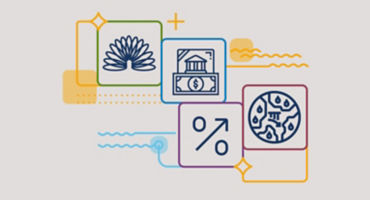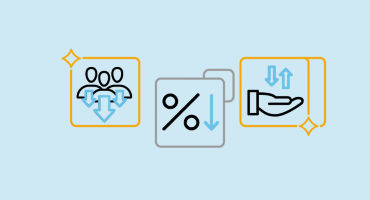Global equities (-2.4%) declined in the third quarter. Market sentiment was dented by concerns about the health of China’s economy, increasing energy prices, and rising government bond yields amid the prospect of an extended period of high interest rates. Global central banks varied their approaches to monetary policy in response to differing rates of inflation and economic growth across countries and regions. The US Federal Reserve (Fed) held interest rates stable in September amid moderating inflation but signaled a tighter policy path over the next two years amid a strong labor market and a better outlook for US economic growth. In a potential step toward phasing out Japan’s ultra-easy monetary policy, the Bank of Japan (BOJ) allowed greater flexibility for government bond yields to fluctuate but ultimately held rates stable amid extremely high uncertainties surrounding economies and financial markets domestically and abroad. China’s economy showed signs of stabilizing in the wake of the government’s recent policy adjustments, as macroeconomic indicators for manufacturing, services, retail sales, credit growth, and inflation improved. However, the beleaguered property sector remained the key impediment to a sustained recovery. Crude oil prices rallied to a 10-month high after Saudi Arabia and Russia extended production cuts to the end of the year, reducing crude inventories by 3.3 million barrels a day and marking the biggest global deficit since 2007.
Global fixed income markets generated negative total returns during the third quarter as a result of the sharp rise in sovereign yields. While inflation expectations moved higher in some markets, increasing real yields drove the bulk of the move in government bond yields amid resilient economic data and the “higher for longer” policy-rates narrative. Most spread sectors produced positive excess returns as spreads ended little changed. The US dollar strengthened versus most currencies.
Commodities (+16.0%) rallied in the third quarter, driven by a sharp rise in energy, with industrial metals also posting positive returns. In contrast, agriculture & livestock and precious metals ended the period in negative territory.
Equities
United States
US equities (-3.3%) were pressured by surging Treasury yields amid firming views that the Fed will keep interest rates elevated for a prolonged period. Even as household budgets were strained by tightening credit conditions and lofty prices, markets dialed back the probability of recession as cooling inflation, a solid job market, and resilient consumer spending increased the potential that the US economy could achieve a “soft landing.” Over the three months through August, the Personal Consumption Expenditures Index (PCE) — the Fed’s preferred inflation gauge — rose at a modest annualized pace of 2.2% at the core level, signaling that inflation continued to trend lower and the Fed is near the end of its rate-hiking cycle. However, a combination of persistent inflation in some areas and a brighter outlook for economic growth and hiring led the Fed to predict one more interest-rate hike in 2023 and a tighter policy path over the next two years to ensure that inflation is sustainably lower. Second-quarter earnings for companies in the S&P 500 Index were markedly better than anticipated, with earnings declining approximately 4.1% year over year against expectations of a 7.0% decrease. A broadening labor strike against the three major US automakers, which began on September 15, is estimated to have cost the US economy US$4 billion over the first two weeks of the strike. US lawmakers narrowly avoided a government shutdown by passing bipartisan legislation that extended government funding through mid-November.
Economic data released during the third quarter indicated healthy momentum in the US economy after GDP in the second quarter grew at a surprisingly strong 2.1% annualized rate. The labor market remained resilient but showed signs of cooling amid less robust employment growth, declining job openings, slowing wage growth, and an uptick in the unemployment rate to 3.8% due to higher labor-force participation. Consumer outlays softened in August after a burst of spending in the previous two months; monthly retail sales (excluding gasoline) grew only 0.2% after a 0.7% increase in July, while consumer spending advanced 0.4% following a 0.9% gain a month earlier. The sturdy labor market continued to bolster incomes and support purchasing; however, markets were concerned about the durability of spending in the months ahead due to headwinds from higher prices, resuming student loan payments, and tightening credit conditions. Sentiment among small businesses remained historically depressed, and the Conference Board’s Consumer Confidence Index fell sharply in August and September amid a weaker outlook for household finances and the labor market and waning intentions to purchase big-ticket items. The housing market was constrained by limited inventory, elevated prices, and the highest mortgage rates in decades. In August, a surprisingly robust expansion in the services sector underscored the resilience of consumer demand, while accelerating prices for materials and wages showed that inflation remained persistent in the sector. Encouragingly, manufacturing activity improved throughout the quarter.
Within the S&P 500 Index (-3.3%), nine of the 11 sectors posted negative results for the quarter. Energy (+12.2%) was the top-performing sector. Communication services (+3.1%) also outperformed, most notably interactive media & services (+7.6%). Utilities (-9.2%) and real estate (-8.9%) were the worst-performing sectors. Consumer staples (-6.0%) also underperformed, led lower by beverages (-6.2%) and food products (-8.3%). Information technology (-5.6%) declined while technology hardware, storage & peripherals (-11.3%) and software (-5.2%) were the largest detractors.
Europe
European equities (-2.0%) declined as persistent weakness in macroeconomic indicators pointed to a darkening economic outlook for the region. Second-quarter GDP growth was revised down to 0.1% from an initial estimate of 0.3%, while the European Commission (EC) downgraded the eurozone’s economic growth forecast for 2023 to 0.8%, from 1.1% projected in May, amid contracting manufacturing, faltering trade with China, reduced government support, and strained consumer spending due to high inflation and rising borrowing costs. In an effort to battle persistent inflation, central banks across Europe continued to tighten monetary policy. However, after raising interest rates by 50 basis points (bps) during the quarter, the European Central Bank (ECB) conceded that its focus will likely shift to the duration of restrictive policy rather than the level, signaling that borrowing costs may be high enough to return inflation to the bank’s target. Additionally, downside risks to economic growth gained greater prominence among policymakers, with tightening financial conditions likely to further constrain economic activity and cool inflationary pressures. Preliminary estimates showed that eurozone headline inflation fell to 4.3% in September, from 5.5% in June, and core inflation dropped more than expected to 4.5%, from 5.5%, underlining that tightening monetary policy has been effective. The EC launched an anti-subsidy investigation on Chinese electric vehicles, heightening trade tensions between the European Union and China. Second-quarter earnings for companies in the STOXX 600 Index are forecast to decline by 5.9%, better than prior estimates.
Europe’s manufacturing sector remained mired in a deep downturn over the quarter; the HCOB Eurozone Manufacturing Purchasing Managers’ Index (PMI) registered 43.4 in September, unchanged from June, as new orders continued to shrink at a pace rarely seen since 1997, job losses accelerated, and business confidence deteriorated. The Flash Eurozone Composite PMI in September showed that services sector activity edged higher but contracted for the second consecutive month, led by the sharpest reduction in new business since the pandemic. Services input costs, including wages, rose for the second straight month, but output prices continued to soften. The EC’s Economic Sentiment Indicator declined further over the quarter, sliding to 93.3. In September, consumer confidence declined markedly for the second month in a row due to the prevailing pessimistic economic outlook, while industry confidence showed signs of stabilizing.
Amid ongoing strains from energy price shocks, high interest rates, and a subdued global economy, Germany’s (-4.9%) economy is forecast to contract by 0.6% in 2023 and grow 1.3% in 2024, worse than previous estimates according to the Joint Economic Forecast. The ZEW Indicator of Economic Sentiment increased more than anticipated in September, driven by expectations of stable eurozone interest rates, but the assessment of the economic situation continued to worsen considerably. In the UK (+2.6%), economic activity contracted in September, with the S&P Global/CIPS Flash Composite PMI dropping to 46.8, from 48.6 in August, driven by a continued decline in manufacturing output and a steep drop in the services sector. The Bank of England (BOE) halted its cycle of interest-rate hikes after headline inflation surprisingly eased to 6.7% in August, from 7.9% in June, and core inflation dropped sharply, to 6.2%. In Spain (-0.9%), conservative People’s Party leader Alberto Núñez Feijóo failed in his second and final attempt to form a government following an inconclusive general election. Acting Prime Minister Pedro Sánchez will now get a chance to secure another term.
Pacific Basin
Pacific Basin equities (+0.3%) ended higher. In Japan (+1.7%), the BOJ surprised financial markets by increasing the flexibility of its yield curve control program, which was interpreted as a shift toward normalized monetary policy. However, BOJ Governor Kazuo Ueda tempered speculation of a near-term interest-rate hike, emphasizing the need to remain accommodative until inflation is driven by higher demand and wage growth and is sustainably near the bank’s 2% target. The bank’s decision to maintain its ultra-easy stimulus put significant downward pressure on the yen. Japan’s core CPI inflation grew at a steady 3.1% year-over-year pace in July and August, but the BOJ forecast that inflation would drop to 1.9% in 2024 and 1.6% in 2025. Prime Minister Fumio Kishida outlined a new economic stimulus plan featuring measures to reduce the stress of inflation on households, boost wages, and spur domestic investment in key growth areas like semiconductors and batteries.
Australia’s (-0.3%) second-quarter GDP advanced by a greater-than-anticipated 0.4% (2.1% annually), but Treasurer Jim Chalmers warned that the country’s economic growth may be substantially weaker going forward due to the stresses of higher interest rates and a slowdown in China — the country’s largest trading partner. The Reserve Bank of Australia (RBA) maintained its tightening bias in September but left its key interest rate unchanged at 4.1% amid the risks of a sharp slowdown in economic growth and consumption. In August, business confidence and business conditions picked up, but consumer confidence fell further into “deeply pessimistic” territory. Retail sales also trended downward during the quarter, suggesting that consumers are feeling the strains of high interest rates. Encouragingly, annual core inflation slowed to 5.5% in August, increasing the likelihood that the RBA is close to the end of its rate-hiking cycle. Tightness in the labor market eased during the quarter, but a near-historic low in unemployment contributed to the RBA’s unease about inflation.
In Hong Kong (-11.1%), government officials lowered their outlook for economic growth amid a waning post-pandemic recovery and economic weakness in China and the rest of the world. GDP is now expected to expand 4% – 5% in 2023, compared with the previous prediction of 3.5% – 5.5%. Exports extended their longest streak of monthly declines on record, falling 3.7% year over year in August and weighing on the region’s economy. Stock market trading was halted twice after historic rainstorms brought the area to a standstill and caused damage in excess of US$100 million. In response to lower investor confidence and international investment, the government established a task force to enhance stock market liquidity and reignite market activity. Hong Kong’s slumping property market was further pressured by the highest mortgage rates since 2006. In Singapore (+0.5%), exports dropped 20.1% year over year in August — the 11th straight monthly decline — as slumping demand hobbled the trade-dependent economy. Economists downgraded the country’s 2023 economic growth forecast to 1.0% for 2023, from 1.4% in June.
Emerging Markets
Emerging markets (EM) equities (-1.3%) fell, with all regions ending in negative territory. Latin America led the decline, followed by Asia and Europe, the Middle East, and Africa (EMEA).
In Latin America (-1.6%), central banks’ policy rates diverged from those of developed markets. Brazil’s (+0.1%) central bank lowered interest rates twice, to 12.75%, and second-quarter GDP expanded more than expected, growing by 0.9% from the first quarter. In Chile (+0.6%), the central bank cut policy rates twice following a sharp decline in inflation. Interest rates were also reduced in Peru (-4.0%), where President Dina Boluarte called for a National Pact between all congressional parties and for the government to deliver better policies for the electorate as widespread protests engulfed the country. In Mexico (-5.2%), government officials announced plans to widen the fiscal deficit for President Andrés Manuel López Obrador’s final year in office, with the projected overall 2024 deficit widening to 5.4% of GDP.
Asian equities (-1.3%) were dragged lower by China (-1.9%). Analysts cut China’s economic growth forecasts as foreign investors fled Chinese stocks amid a faltering economic recovery and mounting concerns about the health of the country’s property sector. The central bank slashed its medium-term lending rate, and the government introduced a series of policy support measures to reinvigorate the economy. In September, improving macroeconomic indicators for manufacturing, services, retail sales, credit growth, exports, and inflation tentatively signaled that the country’s economy is stabilizing. However, markets remained anxious about a deepening downturn in real estate, as declines in new-home prices, property investment, and sales clouded the outlook for economic growth. India’s (+4.1%) economy grew at its fastest pace in a year, with GDP accelerating by 7.8% annually in the second quarter amid strong services activity and robust demand. The central bank highlighted the country’s strong and improving economic fundamentals but indicated that persisting global uncertainty poses a risk to the economy. South Korea’s (-4.3%) economic recovery stumbled under the weight of contracting exports and high household debt. President Yoon Suk Yeol navigated a delicate geopolitical situation following improved relations with Japan, as both nations sought separate trilateral agreements with the US and China.
EMEA equities (-0.7%) moved lower. South Africa’s (-4.7%) economy suffered from the impacts of the worst power crisis on record, which is expected to reduce economic growth by 2% this year. The central bank maintained interest rates at 8.25% despite inflation firmly within its inflation target of 3% – 6%, helping to reduce pressure on the rand. Saudi Arabia (+2.2%) extended its voluntary oil production cuts of one million barrels per day through year end, causing oil prices to rally and significantly curbing global oil supplies. Intensifying talks between Saudi Arabia and Israel offered hope that the two countries could strike a historic peace agreement, which would dramatically reshape geopolitics in the Middle East and beyond. Poland’s (-5.7%) central bank surprised markets with a larger-than-anticipated 75 bps cut in interest rates, the first reduction in more than three years. The decision came ahead of a closely contested and divisive parliamentary election in October, which is expected to have far-reaching consequences in Poland and across Europe. Greece (-5.0%) fell sharply, although the country’s debt received a credit-rating boost from Moody’s to Ba1 with a stable outlook (one notch shy of investment grade).
Fixed Income
Economic data generally remained firm, although divergence increased across regional economic blocs. Inflation continued to trend downward from multi-decade highs but remained above the target of most central banks. In the UK, house prices fell sharply, and year-over-year growth in CPI inflation remained among the highest in developed markets. In the US, persistent labor market strength propelled consumer spending, confidence fell sharply during the period, and higher rates took a toll on the housing market. The HCOB Eurozone Manufacturing PMI fell deeper into contractionary territory, dragged down by new orders and employment, while the services PMI expanded at a slower pace. Japanese industrial production declined, partly due to supply chain challenges that impacted semiconductors. The Manufacturing PMI contracted in China, weighed down by weaker global demand and a slowdown in small-business operations.
Sovereign yields were propelled upward by consistent messaging from most major central banks that interest rates will remain higher for longer, in addition to economic growth forecasts that were mostly improved. The US yield curve showed a “bear steepening” amid a robust economy and a hawkish stance from the Fed. In the UK, the gilt curve also steepened, but with a rally at the shorter end, after slowing inflation data increased confidence that the BOE is nearing the end of its hiking cycle. The ECB implemented two rate hikes during the quarter but pivoted to a more dovish stance, believing the current rate level will sustainably reduce inflation back to target. The BOJ retained its accommodative position, indicating a preference for exceeding its inflation target rather than risking a shortfall. Chinese government bonds outperformed after the People’s Bank of China lowered its one-year benchmark interest rate.
Currencies
The US dollar strengthened against most G10 and EM currencies amid a repricing of US policy-rate expectations. European currencies extended their losses as a weakening economic outlook shifted the focus to prospective rate cuts. Stagnating economic conditions in China continued to weigh on the dollar-bloc currencies. The BOJ tamped down speculation of a near-term rate hike and opted to keep its ultra-loose policy unchanged, weakening the Japanese yen, even as the risk of currency intervention escalated. EM currencies broadly weakened. The Chilean peso was the top decliner among major Latin American currencies over the quarter, with metals prices softening on lower demand prospects amid China’s property woes. The Brazilian real fell after the central bank initiated its rate-cutting cycle more aggressively than expected.
Commodities
Energy (+28.8%) rallied during the quarter. Gas oil (+47.9%), heating oil (+41.9%), and gasoline (+10.2%) spiked on concerns about tight supplies due to production cuts by OPEC and Russia. Hot weather also caused a slowdown in refinery production and elevated cooling needs during the period. Crude oil (+29.3%) skyrocketed, supported by signs of a slowdown in Russia’s seaborn crude flows and a 3% drop in US inventory compared to a year earlier. US natural gas (-7.3%) fell due to ample supplies at the end of summer, warmer weather, and forecasts for above-average temperatures across most of the country.
Industrial metals (+3.5%) rose. An improved demand outlook in China along with the Chinese government’s stimulus measures supported zinc (+11.9%). Aluminum (+9.2%) rallied amid a surge in demand from India, driven by the government’s push for new infrastructure, especially for green energy. Lead (+5.3%) ended higher due to tight supply in the physical market. Copper (+0.4%) rose amid optimism over Chinese demand in July. However, prices were subsequently pressured by China’s faltering recovery, tightening global monetary policy, and a rebound in London Metal Exchange inventories from critically low levels. Nickel (-9.0%) fell sharply as uncertainty about China’s property market weighed on the metal.
Precious metals (-3.8%) fell. Gold (-3.9%) and silver (-2.6%) were pressured by rising US Treasury yields and a rally in the US dollar amid the Fed’s messaging that interest rates will remain higher for longer. A stronger dollar and higher yields are generally negative for non-interest-bearing bullion, which is priced in US currency.
Agriculture & livestock (-2.2%) slid lower during the quarter lower. Wheat (-18.4%) slumped after the US Department of Agriculture (USDA) raised its estimate for Russian shipments in the 2023 – 2024 season and boosted its forecast for US wheat stocks by more than markets expected. Coffee (-6.6%) ended lower, driven by weakness in the Brazilian real, accelerated harvesting in Brazil’s growing areas due to dry weather, and rain forecasts later in the quarter that boosted crop prospects. Soybeans (-3.8%) and corn (-3.7%) declined, with the USDA reporting larger-than-expected US supplies. Lean hogs (+0.7%) benefited from strong seasonal demand and retail price cuts, despite a USDA report that showed an unexpected increase in inventory. Feeder cattle (+1.7%) and live cattle (+3.3%) rose as consumer demand remained robust. Cocoa (+1.8%) prices reacted positively to a tight market for cocoa beans due to concerns about El Niño and crop disease that potentially hurt output from Cote d’Ivoire and Ghana. Cotton (+9.9%) and sugar (+16.6%) rose amid persistent heat and drought conditions in key growing regions.








